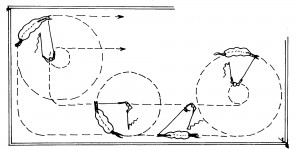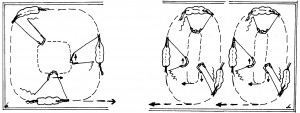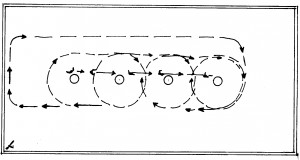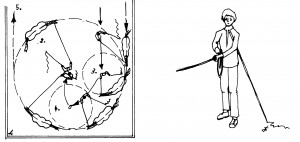Work on the Lunge Line – Part 16
|
|
Arbeit an der Longe – Teil 16
|
More Patterns, more games:
- Let us recall at this point that we don’t belong to those people, who lunge a horse to get him tired, but rather to establish a new and exiting communication resulting in learning something new (both horse and human!)
- If you read “From Leading to Liberty” you will also recall that the purpose of natural horsemanship is to learn the horse’s language for such a dialogue (as he cannot learn ours) – body language. AND that our partnership with the horse should have nothing to do with bossing him around, and not much with obedience either! A good partner and a good leader, though he might have a lot of authority, is also a friend, he is respected because he also pays respect where due.
- It is not easy for your horse to really trust you: remember that he has it stored in his genes that you are the meat-eater and he is the steak!! So the relationship with you is comparable to a tiger-trainer and his cats, whom he knows really well and trusts enough to be in the cage with them, but never relaxes his guard! He also knows that despite the good times had together, when push comes to shove he is still the steak!
- So your horse needs daily reassurance: to tell him that you intend to be a reliable friend you have to behave like one – like a horse-friend would! And this is precisely where the games come in!
- I mentioned in the book “From Leading to Liberty” (see synchronized running games) that one sign of friendship between horses is parallel movement. Another is rhythmic behaviour. So it stands to reason that we reassure the horse more while teaching him his task on the lunge line by moving along – moving in a calm and rhythmic fashion parallel to the horse – rather than staying planted in the middle, demanding obedience to something he can’t observe, and aids, which frighten him more than they help! Flicking a whip around is not necessarily a logical expression of friendship for a horse! Moving parallel, in the same gait and direction, however IS.
- We first practise some playful patterns with the lunge still clipped to the cavesson, because this has a lot to do with coordination. We want to avoid that the horse yanks himself in the mouth when going into unexpected turns – and the lunger must become coordinated with his/her marching patterns as well – It is not easy at first to retain a soft contact with the bit at the same time! Our goal is therefore twofold. In the first pattern we move the circle – this time very precisely – and constantly interchange the curved with straight lines. At the same time we make circles larger and smaller: during the small circle the lunger stands, during the larger ones s/he moves along. Like this the lunge line always remains at the same length (to make the lunger’s job easier for now). Start in walk, then try trot, retaining the precision of the pattern.
|
|
Mehr Muster und Spiele:
- Wir erinnern uns, daß wir nicht zu den Leuten zählen, die ihr Pferd an der Longe nur müde machen, sondern eine neue, interessante Art der Kommunikation mit Lerneffekt (für beide, Mensch und Pferd!) erreichen wollen.
- Wenn Sie “From Leading to Liberty” gelesen haben, erinnern Sie sich auch, daß es der Sinn des “natural horsemanship” ist die Pferdesprache für so einen Dialog zu erlernen (da das Pferd unsere Sprache nicht lernen kann) – mit Körpersprache. UND daß unsere Partnerschaft mit dem Pferd nichts mit rumkommandieren zu tun haben sollte, und auch nicht viel mit Gehorsam! Ein guter Partner und ein guter Führer ist, obwohl er viel Authorität haben mag, auch ein Freund, und er wird respektiert, weil er, wo verdient, auch Respekt zollt.
- Es ist für Ihr Pferd nicht einfach Ihnen wirklich zu trauen: es ist ja in seinen Genen verankert, daß Sie der Fleischfresser sind und es das Steak!! Somit ist die Beziehung vergleichbar mit der eines Tigerdompteurs, der seine Raubkatzen wohl kennt und ihnen auch genug traut sich mit ihnen in den Käfig zu wagen, der aber immer auf der Hut sein wird! Denn er weiß auch, daß er, wenn es ernst wird, immer noch die Mahlzeit darstellt!
- Daher braucht Ihr Pferd tägliche Rückversicherung: um Ihrem Pferd zu zeigen, daß Sie ein verläßlicher Freund sein wollen, müssen Sie sich wie einer benehmen – wie ein befreundetes Pferd es täte! Und dazu sind die Spiele gut!
- Ich habe in “From Leading to Liberty” (siehe synchrone Laufspiele) erwähnt, daß es zwischen Pferden ein Zeichen von Freundschaft ist sich parallel und rhythmisch zu bewegen. So ist es doch einleuchtend, daß es für das Pferd beruhigender ist seine Aufgabe an der Longe zu erlernen, wenn wir mitlaufen – in ruhiger und rhytmischer Weise parallel zum Pferd – anstatt in der Mitte aufgepflanzt, Gerhorsam verlangend zu etwas, das das Pferd nicht beobachten kann, mit Hilfen, die es mehr beunruhigen als helfen! Eine Peitsche zu schnippen ist einem Pferd keine logische Art Freundschaft auszudrücken! Sich parallel in der selben Gangart und Richtung zu bewegen IST es hingegen.
- Wir üben wir nun ein paar spielerische Muster, mit der Longe immer noch im Kappzaum verschnallt, da dies viel mit Koordination zu tun hat. Wir wollen vermeiden, daß das Pferd sich im Maul wehtut, wenn es in unerwartete Kurven geht, und auch der Longeur muß ja erst mit den Mit-Marschier-Mustern vertraut werden – wobei es zunächst nicht so einfach ist, einen leichten Kontakt mit dem Pferdemaul zu halten! Wir haben zweierlei Ziele. Im ersten Muster verschieben wir den Zirkel – aber diesmal viel präziser – und wir wechseln dabei ständig zwischen gebogenen und geraden Linien. Gleichzeitig machen wir die Kreise größer und kleiner: in den kleinen steht der Longeur, bei den größeren läuft er mit. So bleibt die Longe immer dieselbe Länge, um dem Longeur jetzt die Aufgabe zu erleichtern. Fangen Sie im Schritt an, dann Trab, und immer mit ganz präzisem Muster.
|
 Use your whip and your own body position to drive, frame or point out the horse.
Work in very precise patterns!
|
- You can make this exercise more challenging by also changing the tempo within the gait: ask for faster trot on the larger circle, slow him down on the small one. Or ask for faster trot on the straight lines only. Don’t make the pattern too predictable, so the horse stays attentive – but give him fair announcement what to expect by voice aid, before you move the whip. Your body language must be accurate: turn your sternum and face, shoulders and eyes in the direction of travel, when you march off. Drop back into the driving position on the straight lines (as shown), face the horse’s shoulder when driving into the corner. Remember: he observes everything you do – and what he sees has to make sense to him!
|
|
- Sie können diese Übung herausfordernder machen, indem Sie innerhalb der Gangart das Tempo verändern: z.B. einen flotteren Trab auf dem größeren Zirkel und langsamer auf dem kleinen. Oder nur flotter auf den geraden Linien. Machen Sie das Muster nicht zu berechenbar, damit das Pferd aufmerksam bleibt, aber geben Sie ihm immer fairerweise mit Stimme eine Ankündigung was kommt, bevor Sie die Peitsche einsetzen. Ihre Körpersprache muß akkurat sein: drehen Sie Augen, Gesicht und Schultern in Bewegungsrichtung, wenn Sie losmarschieren. Fallen Sie auf den geraden Linien ein bißchen in die treibende Position zurück und drehen Sie sich mehr zu des Pferdes Schultern, wenn Sie zur Ecke kommen. Sie erinnern sich: Ihr Pferd beobachtet alles, was Sie tun – und das muß sinnvoll verständlich sein!
|
 Don’t let the horse cut corners in the square! Be ready with your whip sign early.
Keep an even rhythm as much as possible. Change gaits within the pattern also. |
- Then we move to the square, shifting it from one end of the arena to the other after completion. Watch again how the whip position has to be meaningful. Anticipate that approaching the bend you must point it to the horse’s shoulder to drive him deep into the corner, otherwise the square will change into a sloppy circle, which is not the intent of this pattern! Include transitions from walk to trot. Keep phases short, stop and praise often and always, when something showed improvement! Change hands after the break.
- Try out an oval pattern. Mark the two ends of your oval (where you must end up!) with a cone to keep it precise. Lay three oval across the arena and move from one to the next fluently.
|
|
- Nun probieren Sie das Quadrat und verschieben es nach Durchlaufen in die andere Ecke der Halle. Schauen Sie wieder wie die Peitschenposition sich ändert. Vor Erreichen der Ecke muß sie schon mehr auf die Schulter zeigen, damit es nicht abschneidet, sonst verwandelt sich das Quadrat in einen schlampigen Zirkel. Addieren Sie nun Schritt-Trab Übergänge. Kurze Reprisen, oft Pausen und viel Lob, wenn etwas besser geklappt hat! Dann üben Sie auf der anderen Hand.
- Beim ovalen Muster markieren Sie die beiden Enden, wo Sie stehen sollen, mit einem Hütchen, um genau zu arbeiten. Legen Sie 3 Ovale in der Halle und gehen Sie von einem zum anderen.
|
 The lunger should move on a straight line and with regular strides – also backward !
Train your eyes to hit the gap correctly. Keep the horse in regular trot.
|
- Set up a row of cones or barrels on the centre line of the arena. The lunger moves on a straight line next to them, the horse rounds each barrel once and proceeds to the next. Pass the lunge over your head without getting tangled up. In our film “Playing with Horses” you can see that this also works with a group of horses! It is a lot of fun and very useful for coordination and training your eye, so you hit the gaps accurately. On the way back the lunger walks backward, still on a straight line.
|
|
- Bauen Sie eine Reihe Hütchen oder Tonnen auf der Mittellinie der Halle auf. Der Longeur muß sich daneben auf einer geraden Linie bewegen. das Pferd umrundet jede Tonne einmal und ab zur nächsten. Führen sie die Longe über Ihren Kopf ohne sich zu verheddern. In unserem Film film “Playing with Horses” (auch deutsch) sehen Sie, daß es sogar mit drei Pferden klappt! Es macht viel Spaß und ist nützlich, um Ihre Koordination und Ihr Auge zu trainieren, so daß Sie die Lücken richtig treffen. Auf der Rückreise läuft der erfahrene Longeur rückwärts.
|
 Practise picking up the lunge and letting it out again in a fluent motion.
Get well coordinated and park the whip under your arm pit while doing this! |
- This pattern is much more challenging to the lunger, as here you must constantly shorten and lengthen the lunge line, while you move with your horse! Coming from the straight line (1.) start on the large circle and get organised in your mind of where to plant your first volte. Step half way toward the horse, shortening the lunge line, (parking the whip under your arm pit) and picking it up with the help of the second hand as shown. This is the only time when you handle the lunge with both hands (check blog 9 for correct pick-up of a tangle-free lunge). After two small voltes, which you shift as shown, you step back to the centre of the large circle, feeding out the line again. Watch your body language for clearness! Keep your sense of humour and stop when you get muddled. Once a pattern like this flows effortlessly, you can be proud of yourselves!
- Now to the hand-change! On the video in Blog 11, where my horse performs it off-line, you saw the body language required. You can also check the very clear illustrations in the book (LtL) page 165, and of course in our films.
|
|
- Dieses Muster ist für den Longeur schwieriger, weil Sie hier ständig die Longe aufnehmen und heraus lassen müssen, während sie mit dem Pferd mitlaufen. Von der Geraden her (1) gehen Sie auf den großen Kreis und planen Sie im Geiste wo die erste Volte liegen soll. Halbieren Sie den Abstand zum Pferd mit Aufnehmen der Longe (Peitsche unter der Achsel) mit Hilfe der Peitschenhand. Dies ist die einzige Situation, wo Sie die Longe in beiden Händen haben (siehe Blog 9 für korrektes Aufnehmen der Longe). Nach 2 kleinen Volten, die Sie wie gezeigt verschieben, schreiten Sie wieder in die Mittel des großen Zirkels mit Auslassen der Longe. Ihre Körpersprache muß derweil klar sein! Bewahren Sie Ihren Humor und halten Sie an, wenn es zu verwickelt wird. Wenn so ein Muster mal mühelos fließt können Sie stolz auf sich sein!
- Nun zum Handwechsel! Auf dem Video im Blog 11, wo mein Pferd es ohne Seil ausführt, können Sie die Körpersprache noch einmal ansehen. Sie können auch die klaren Illustrationen im Buch Seite 165 und natürlich unsere Filme noch einmal anschauen.
|
 The Bretzel and Cloverleaf will later be your horse’s favourite off-line games!
Now train on the lunge, learn the pattern well and don’t confuse him! |
- The Bretzel pattern is a figure eight with a variation to a wide arc in between. The main difficulty for beginners lies in the fact that you have to get out of your horse’s way during the hand-change, stepping back and not body-blocking him! You have to move in a coordinated way and plan your next stand-point accurately. Walk the pattern with your horse first, put two cones down or train around barrels (in the film I do it around two horses lying-down!). Once you master this, you are ready for the Cloverleaf! Study the pattern well – this exercise is learned off-line by just about any horse in 20 minutes, but it takes a lot longer for the humans to get it!
- It consists of :Going around barrel A, lunger retreats to the centre, hand-change! Head for barrel B – NO hand-change… lunger walks on a straight line from barrel B to C. Hand-change (lunger retreating to the centre). From there to barrel D without hand-change… and so on. You can see in the photo what a joyful game this is for the horse!
Dialogue on the lunge line:
Once you have mastered all these pre-exercises on the cavesson, and your horse understands you and your body-language in all patterns, you are both ready for the dialogue on the bit.
Next time: the true dialogue!
|
|
- Die Bretzel ist eine Achterfigur mit einem Bogen dazwischen. Die Hauptschwierigkeit für den Anfänger liegt darin, daß man beim Handwechsel dem Pferd aus dem Weg sein muß, um es nicht zu blockieren. Sie müssen ruhig und koordiniert schreiten und den nächsten Standpunkt gut planen. Laufen Sie das Muster erst zusammen mit Ihrem Pferd und stellen Sie vielleicht 2 Hütchen oder Tonnen auf (im Film bretzele ich um 2 liegende Pferde). Wenn Sie das beherrschen können Sie das Kleeblatt wagen! Studieren Sie das Muster genau – jedes Pferd hat bisher ohne Seil das Muster in 20 Minuten gelernt, aber die Menschen brauchen viel länger!
- Es besteht aus:Umrunden von Tonne A, der Longeur zieht sich in die Mitte zurück, Handwechsel! Zeigen in Richtung Tonne B – KEIN Handwechsel… der Longeur schreitet auf einer geraden Linie von B nach C. Handwechsel (Longeur wieder in die Mitte). Von hier zur Tonne D ohne Handwechsel … und so weiter. Im Foto sieht man deutlich wie viel Spaß es dem Pferd macht!
Dialog an der Longe:
Sobald Sie alle diese Vorübungen am Kappzaum gemeistert haben, sobald das Pferd Sie und Ihre Körpersprache in all den Mustern verstanden hat, sind sie nun beide bereit für den echten Dialog am Gebiß.
Nächstes Mal: der wahre Dialog!
|






